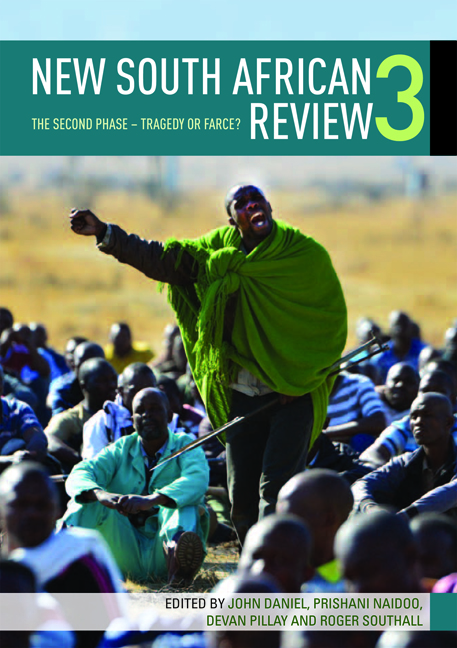Book contents
- Frontmatter
- Contents
- Preface
- Introduction: The second phase – tragedy or farce?
- PART 1 Party, Power and Class
- PART 2 Ecology, Economy and Labour
- Introduction: Ecology, economy and labour
- Chapter 5 Mass unemployment and the low-wage regime in South Africa
- Chapter 6 Nationalisation and the mines
- Chapter 7 Broad-based BEE? HCI's empowerment model and the syndicalist tradition
- Chapter 8 ‘Ask for a camel when you expect to get a goat’: Contentious politics and the climate justice movement
- Chapter 9 Hydraulic fracturing in South Africa: Correcting the democratic deficits
- PART THREE Public Policy and Social Practice
- PART 4 South Africa at Large
- Contributors
- Index
Chapter 8 - ‘Ask for a camel when you expect to get a goat’: Contentious politics and the climate justice movement
from PART 2 - Ecology, Economy and Labour
Published online by Cambridge University Press: 31 May 2019
- Frontmatter
- Contents
- Preface
- Introduction: The second phase – tragedy or farce?
- PART 1 Party, Power and Class
- PART 2 Ecology, Economy and Labour
- Introduction: Ecology, economy and labour
- Chapter 5 Mass unemployment and the low-wage regime in South Africa
- Chapter 6 Nationalisation and the mines
- Chapter 7 Broad-based BEE? HCI's empowerment model and the syndicalist tradition
- Chapter 8 ‘Ask for a camel when you expect to get a goat’: Contentious politics and the climate justice movement
- Chapter 9 Hydraulic fracturing in South Africa: Correcting the democratic deficits
- PART THREE Public Policy and Social Practice
- PART 4 South Africa at Large
- Contributors
- Index
Summary
INTRODUCTION
The climate crisis is deepening. Despite seventeen years of multinational negotiations there is no binding global agreement on the reduction of carbon emissions. In fact, carbon emissions are rising, which means that climate change will intensify and have devastating effects – particularly on the working class – in the form of rising food prices, water shortages, crop failures and so on. Shifting to a new energy regime will be particularly challenging for South Africa, given the carbon-intensive nature of our economy and the continued dominance of the ‘minerals-energy complex’.
The failure of the multinational has generated an emphasis on the mobilisation of civil society. As environmental justice analyst David Hallowes states, ‘the “theatre of engagement” needs to shift away from the international negotiations’. Civil society, however, contains deep differences and serious power imbalances, as the 2011 Global Day of Action march demonstrated.
Theatrical elements were in evidence in this march of 15 000 people from all over the world to the site of the COP17 negotiations in Durban. It was a very colourful event, with different movements marching in their battalions, singing and chanting ‘A people united will never be defeated’. There were the 400 members of the Rural Women's Assembly in their green T-shirts proclaiming ‘WOMEN – THE GUARDIANS OF SEED, LIFE AND EARTH’; 500 Democratic Left Front and Climate Jobs campaigners in red with the slogan ‘LISTEN TO THE PEOPLE. END CAPITALISM NOT NATURE’; SA Transport and Allied Workers’ Union (Satawu) members in orange; giant banners bearing differing messages; puppets; a balloon proclaiming ‘RIGHTS FOR MOTHER EARTH NOW’; an inflated octopus wearing an ‘Uncle Sam’ hat; some of Via Campesina's 200 million worldwide members; a funeral procession following a coffin to mark the end of ‘King Coal’; loud chants such as ‘Away with the capitalist agenda, away!’ (as well as ‘Phantsi COP17 that does not represent the people, phantsi!’); and three topless women carrying an anti-nuclear banner. At first glance it seemed a powerful illustration of the World Social Forum slogan of ‘Unity in Diversity’ with many different traditions and forms of struggle all heading in the same direction and converging at the International Convention Centre.
- Type
- Chapter
- Information
- New South African Review 3The second phase - Tragedy or Farce?, pp. 154 - 172Publisher: Wits University PressPrint publication year: 2013

